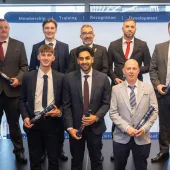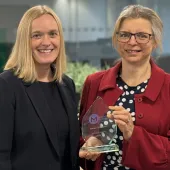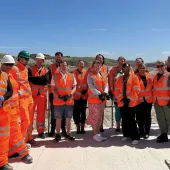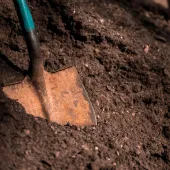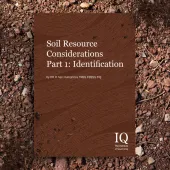Annual Conference 2007 Review
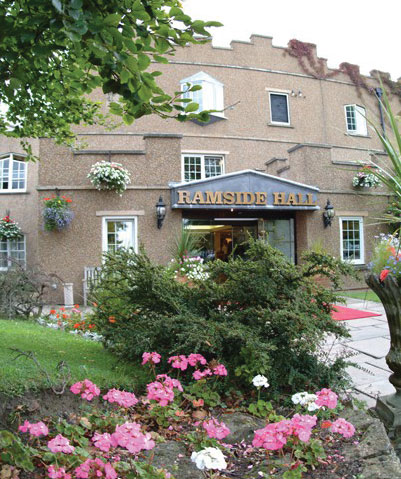
Geordies add value
The Annual Conference 2007 was hosted by the North of England branch at the Ramside Hall Hotel, Durham, on the 4 and 5 October. The venue is set in a golf course and parkland only minutes from the cathedral city of Durham and the A1(M) motorway.
The North of England branch committee, which took the lead in identifying speakers for the symposium and the format of the traditional ‘Welcome dinner’, must be congratulated for creating an informative and thoroughly enjoyable event. Any concerns that the ‘North’ is foggy, wet and dour were dispelled by bright sunshine, stimulating speakers and excellent hospitality and humour.
The theme of the symposium was ‘Quarrying; Adding value’. Speakers had been asked to address this theme by discussing the many ways in which individuals, employees and the community derive benefit from the quarrying industry.
The proceedings began with a welcome by Chris Snowball, chairman of the North of England branch, who introduced the President, Cedric Hollinsworth, to award the prizes beginning with those for the Institute’s Professional Examination.
[img_assist|nid=12250|title=Tracy Dennis|desc=|link=none|align=left|width=201|height=200]First among the prize-winners was Tracy Dennis, who won the most prestigious Leonard Clugston Prize for obtaining the highest number of marks in the IQ Professional Examination. She also won the Reginald W. Coles Award for Health & Safety and came runner-up for the Rex Nord Award for Quarry Operations (Blasting). Diarmuid Kirwan then received his prize as runner-up for the Rex Nord Award. This year saw the implementation of a decision by Council to significantly increase the value of the Leonard Clugston Prize and to revert to the use of the name of the prize as defined in the original trust deeds. It is regrettable that several of the nine prize-winners were unable to attend.
There then followed the presentation of awards for members who had presented papers to meetings of The Institute. The judges had decided to give the Marston Award to Stephen Savery for his paper describing his experience as an expert witness in litigation related to ‘competence’ but, unfortunately, he was unable to attend owing to a recent operation. The Ruston Bucyrus Award went to John Barritt of WRAP for his paper on research into aggregates recycling presented to the annual conference last year.
Finally, the President explained that he had been unable to differentiate between the entries submitted by South Wales and West of England for the President’s Trophy. Thus, he invited Andy Shakeshaft, chairman of the West of England branch, and Glyn Cullen, chairman of the South Wales branch, to share the trophy. This joint award means that the West of England branch has won the trophy six times and South Wales branch twice!
The symposium was arranged simply as two consecutive sessions chaired by the President, Cedric Hollinsworth, and the newly elected Chairman of Council, Martin Isles. Continuing the experiment of improving the experience of delegates, a huge screen was mounted in the centre of the stage set and plasma ‘repeater’ screens were provided on each side wall. Once again, the entire proceedings were ‘filmed’ and recorded on DVD and live images of the speaker were switched to the screens as appropriate. A further innovation was the spacious ‘cabaret’ style of the seating, which appeared to be appreciated by the delegates.
[img_assist|nid=12251|title=Steve Black|desc=|link=none|align=right|width=266|height=200]The first speaker to be introduced by the President was the motivational coach, Steve Black, himself a Geordie. Steve had played sport himself (football and boxing), but is now best known as a coach. He has assisted international players such as Johnny Wilkinson and Rob Andrew and also famous teams including Newcastle United, when managed by Kevin Keegan, and the England Rugby team. But his techniques are also in demand by Fortune 500 companies who want to motivate their employees to make them more valuable to the business; adding value to people.
In an entertaining session, Steve delivered a wealth of advice on the creation of a culture of success rather than survival. In his opinion, borne out by numerous case histories, it was fundamentally important to have an optimistic attitude to work and life. Enthusiasm is contagious and positive thinking leads to positive actions, which then become behaviour. Ultimately, others will interpret behaviour as character and people generally want to be associated with, and emulate, successful achievers.
It is important to reward achievement at all levels of an organization to generate confidence and a sense of worth in all employees, not just the ‘prize-winners’. It must also be remembered that the creation of a stimulating working environment is the responsibility of all employees, not just the managers. Every player has an important role in the team.
Finally, Steve invited delegates to share any experiences by contacting him at: steve@steveblack.co.uk
The next presenter was Terry Lowdon, who described the objectives and work of the National Industrial Symbiosis Programme (NISP). The Government (DTI) is funding some activities from the Aggregates Levy Sustainability Fund, including the establishment of Knowledge Transfer Networks (KTNs) in 12 regions with the aim of reducing waste and benefiting society generally. In essence, the Resource Efficiency KTN brings businesses into contact with each other in the hope that the waste generated by one activity will form the feedstock for another and thereby reduce waste, reduce CO2 emissions and save landfill space; ‘Waste is a resource in the wrong place’. The network connects over 8,500 businesses at present, including many quarrying companies, and is expanding all of the time. Terry cited two examples: the conversion of coal dust/slurry to a handleable product from which energy could be derived; and ‘Trenchmod’, a process to convert excavated soils to a granular sub-base.
An excellent example of utilization of quarry ‘waste’ to the benefit of citizens of two countries was then described by Terje Johansen of Stema Shipping. Coastal erosion can be prevented by five principal means; sacrifice or creation of soft coastal margins, beach replenishment, concrete walls, wooden groins or rock armour. The first is often unacceptable, the second and third very expensive, the fourth consumes hardwood and the fifth requires large, regular blocks of rock.
About 2.5 million tonnes of waste rock are generated by the dimension stone quarries around Larvik, which produce the very characteristic pearlescent blue-grey Larvikite, sometimes referred to as ‘Banksite’ owing to extensive use as cladding on prestigious buildings. Approximately 90% of the quarried rock becomes waste and significant problems are created by its disposal owing to lack of space.
Large waste blocks are separated by Stema Shipping and fashioned into regular blocks using hydraulic hammers. Specialized handling equipment, ships and barges are then employed to deliver the armour stone directly to the beach and point of use.
The next presentation certainly caught the attention of the audience and caused not a little consternation! David Gibson of Crutes law firm in Newcastle outlined the implications of recent employment-related legislation, especially the Work and Families Act 2006 and regulations pertaining to age discrimination and flexible working. These are all intended to add value to employment and extend the opportunity for employment to a wider section of society by eliminating discrimination and introducing more flexibility.
For example, women will now have a right to 12 months maternity leave irrespective of length of service, and the concept of ‘penguin parenting’ is being introduced whereby parents can share the maternity/paternity leave entitlement. Keeping in touch (KIT) days for staff on maternity leave need to be considered. Regulations on age discrimination make it illegal to state minimum ages for positions during recruitment, so job specifications must stipulate qualifications and type of experience required rather than age and length of experience. A further concern is the threat of legal action by staff who feel offended by ageist comments or banter in the workplace. The right to flexible working has been extended from those caring for young or disabled children to those caring for adults.
In answer to questions, David advised that all employers should review their policy on maternity leave, flexible working and procedures for recruitment and promotion of staff, and undertake some basic training of their employees in the implications of the new legislation.
Helen Kennedy, a landscape architect with Wardell-Armstrong, began her presentation by correcting the title from ‘Presentations to impress’ to ‘Selling a scheme to a resistant public’. She admitted that suspicion is a genuine emotion within the members of a local community, partly created by ignorance of the quarrying process and partly by the lack of comprehension of the impacts of the development and mitigation measures. In this respect, she was pleased to see the virtual quarry on the QPA website.
Historically, quarry development has been described by stage plans or by photomontages. In practice, 2D plans are meaningless to most people outside the industry and photomontages can only show a limited number of viewpoints. They are also difficult to modify during the consultation process. Her company prepares 3D models using digital terrain models overlain by aerial photographs which permit a ‘fly-through’ and viewing from any chosen location. They are also relatively easy to modify during the design and consultation process. In her experience they add greatly to the planning process, generating confidence and trust within the community.
[img_assist|nid=12252|title=Mary Lakin|desc=|link=none|align=left|width=150|height=200]Mary Lakin came from Northern Archaeological Associates, based in Barnard Castle, Co. Durham, to explain the techniques and stages of an archaeological investigation and to discuss the role of archaeology in the planning system under the title ‘Archaeology – threat or opportunity?’
Archaeology is often seen by the quarrying industry as the ‘bogie man’ of the planning system, she said. It is a fact, however, that mineral extraction is second only to urbanization as a cause of the loss of archaeologically important sites. She then described the 10 stages of an archaeological investigation so that delegates were fully aware of the activities and timescale. Using many sites by way of example, she explained how the impact on archaeology can be mitigated.
As an unrealized opportunity, the large scale of the exposure of archaeological discoveries made possible by quarrying needed to be better publicized as adding value to the knowledge of the community about its own society and culture. This was especially true today when soils can provide information on climatic history.
David Jarvis Associates and Prof Geoff Walton had collaborated on research sponsored by MIRO and ODPM into alternative forms of quarry restoration, especially restoration to the ‘built environment’. David cited some well known examples such as the Eden Project, Bluewater and Hampton, but stated that this form of non-agricultural restoration is not common and is not promoted by MPG7. However, the restoration of former quarries to housing, retail parks, industry and leisure centres, for example, relieves the pressure on greenfield sites. He catalogued the reasons for this situation including:
- planning complexity incurred by the additional development
- reluctance of landowners to agree to alternative, permanent land-use
- status of restored quarries as greenfield sites
- difficult access and steep final slopes necessitated by the planners’ desire to restrict the land-take and boundaries.
As a result, restoration to the ‘built environment’ has often been a variation to the original permission involving restoration to agriculture or nature conservancy, but now needs to be considered at an earlier planning and design stage. The report contains recommendations on the ways in which this situation might be achieved.
The presentation was concluded by Geoff Walton who described the planned restoration of a derelict quarry on the coast of Cornwall to a mixed development comprising housing, industry and a marina. The audience was treated to a very impressive ‘fly-through’ of the proposed development.
[img_assist|nid=12253|title=Miles Watkins|desc=|link=none|align=right|width=150|height=200]The final presentation of the symposium was made by Dr Miles Watkins, director group environment and corporate social responsibility for Aggregate Industries, under the title ‘Adding value to society’. He said the industry should not be complacent in the knowledge that it provided essential raw materials but that it was necessary to quantify these benefits and broadcast the contribution that quarrying made to the community. The mission of his company was ‘to be the most respected and attractive company in our industry’ and he set out the way in which Aggregate Industries was fulfilling this mission.
The four most important issues that needed to be quantified and published were: climate change and the carbon footprint in terms of CO2 per tonne of product; sustainable construction and usage of the ‘built environment’; benefits to the local community and stakeholders; and biodiversity.
The first can be calculated and reduced by energy-efficiency measures and the second is being addressed through involvement in projects such as the construction of ‘zero carbon’ homes and the recycling of construction materials. Biodiversity is an integral part of the company’s plans to restore quarries. The benefits to the local community must be quantified in terms of salaries, donations of money and materials, and purchases of goods and services. In this respect, it is important to determine the proportion of the workforce that live in the local community and the number of local business transactions.
The triennial McPherson Memorial Lecture has been given since 1974 so the 2007 Annual Conference was the occasion for the 12th lecture in memory of Simon McPherson, founder of Quarry Managers’ Association, which became The Institute of Quarrying.
This year the honour went to Dr Chris Luebkeman, director for global foresight and innovation with ARUP, who delivered a lecture on ‘The future of transportation’. Chris is both an engineer and an architect and has taught internationally at several universities including the Massachusetts Institute of Technology (MIT). His present interests are the effects of globalization on business and the integration of technology into houses to create intelligent homes. His job is to anticipate change and make sure that ARUP get there first.
Chris gave a ‘tour de force’ of the history of transport, especially the motor car, including many illustrations of the wildly improbable predictions that have been made in the past. A common international problem, perhaps the only universal problem, is the traffic jam, and innovative lateral thinking will be needed to resolve this crisis facing transport.
Today, personal transport is considered to be essential because it confers mobility and mobility confers freedom. But will this remain so in future society when people work from home or where they are using modern communications technology? Will people still migrate to cities where, historically, employment and facilities have been located together if such proximity is no longer necessary or advantageous? A change of approach will be needed from (i) concern with costs to identification of benefits, (ii) co-location of activities to the distributed society, (iii) static to dynamic situations and from fear of the future to a visionary expectation.
Some actions can be recommended today, such as revegetation of derelict sites to reduce the carbon footprint of industrial activity and the promotion of ‘home grown’ or ‘home-produced’ goods, the familiar ‘Made in Britain’ branding, thereby reducing movement of goods.
Historically, the first thought was that transport would move to the skies above cities and an electric ‘city’ car was manufactured by Studebaker in 1905! So, nothing is new but the context is very difficult to predict. In retrospect, one thing can be said for certain and that is that the future has always been underestimated and limited by imagination.
The North of England branch committee had given a lot of thought to matching the social events to the location of the conference. On the Thursday evening, delegates and guests were ‘tret’ to a ‘Geordie Night’ at the hotel, which co-operated by dressing all staff in local costume and serving local dishes such as ‘singing hinnies’. Diners were welcomed by a Northumbrian piper, Johnny Handle, who subsequently entertained them with folk songs and a piano accordion. Further entertainment was provided by a leek competition, a meat auction and whippet racing.
On Friday, the outing for partners of the delegates comprised a visit to Durham Cathedral, probably the most important Norman building in Europe. In the evening, the North of England branch held their annual dinner and dance, which was open to delegates and attracted 160 members and guests. Those that stayed after the symposium enjoyed a hilarious act by Geordie comedian Brendan Healy and one of the best bands, ‘Urban Spacemen’, that have performed at an annual conference. Once again, the ladies’ gifts of glass roses made at the Sunderland Glass Museum were purchased with funds generated by the former Associates’ Section.
[img_assist|nid=12254|title=IQ exhibition|desc=|link=none|align=left|width=266|height=200]As has become the custom, the symposium was also the occasion for a small exhibition by organizations and companies associated with the quarrying industry. This year’s exhibitors were EPIC, EMP Awarding Body, IAT, WRAP and GWP Consultants. The Institute is also especially grateful to Marubeni-Komatsu, who were the principal sponsors of the conference event.


